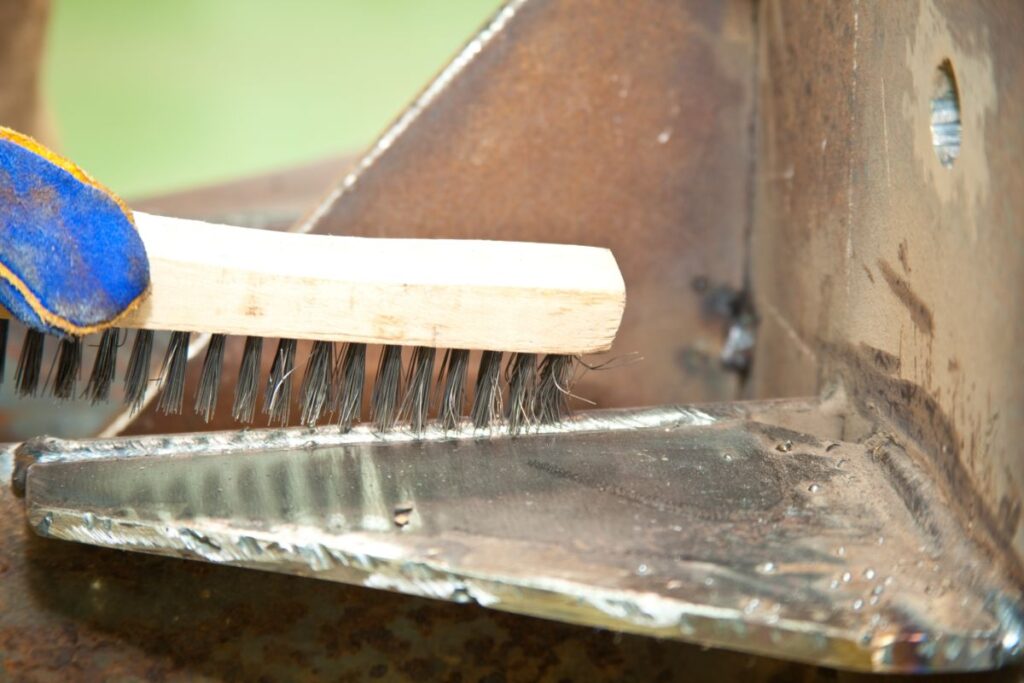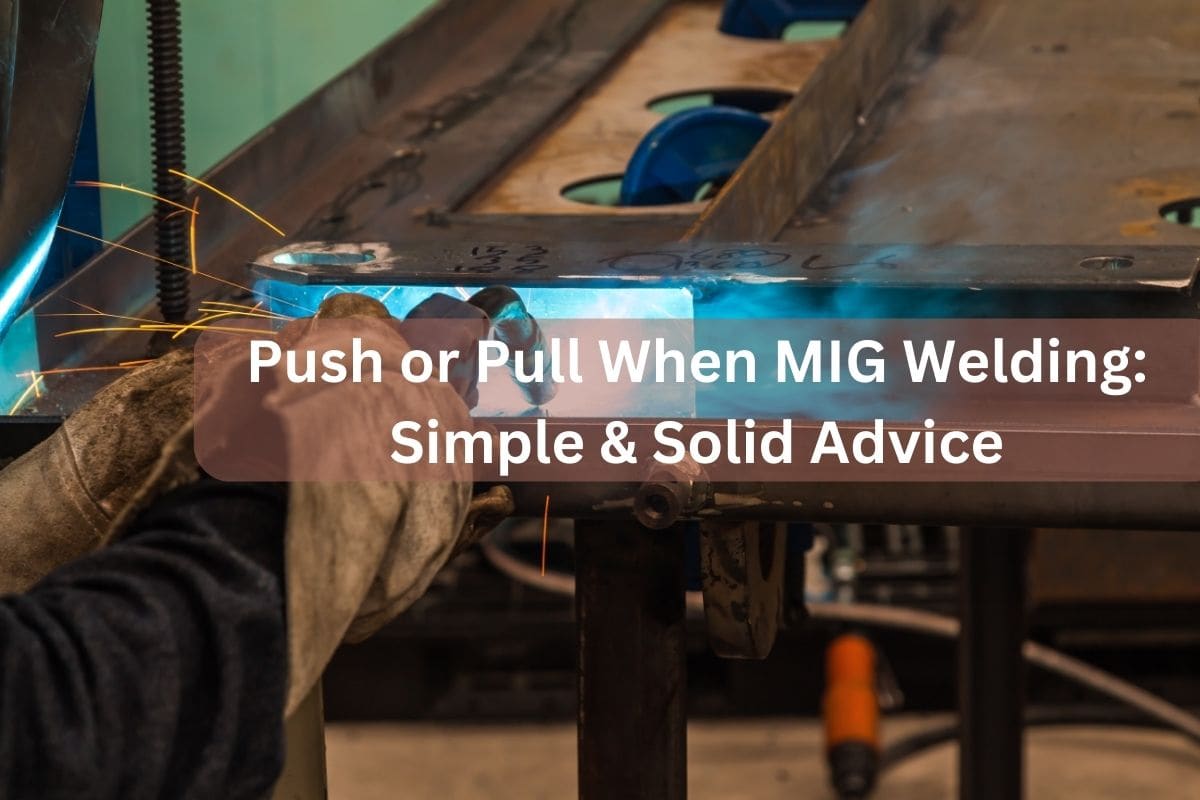Ever found yourself in a quandary about whether to push or pull when MIG welding? You’re not alone!
The debate has been as hot as the weld itself since the dawn of welding machines.
But, in the sprawling world of MIG (Metal Inert Gas) Welding, technically Gas Metal Arc Welding, knowing when to push or pull can mean the difference between a strong bond and a weak one.
Dive in, as we untangle this intricate dance of push vs. pull.
Why Does the Direction Matter?
Imagine painting a canvas. Your brush strokes create different effects, right? Similarly, in MIG welding, your ‘brush’ is the welding gun.
The angle and direction in which you wield this tool can affect the depth and width of your weld. It’s not just about laying down metal; it’s about ensuring strength, durability, and sometimes, aesthetics.
The Three Main Techniques in MIG Welding
Understanding the travel angle and direction of the welding gun is pivotal. These factors majorly influence the weld’s depth and width.
Let’s break down the three primary techniques based on the angle:
- Forehand (Push) Technique
This approach is like smoothly brushing paint on a surface. It produces a flatter, broader weld, offering an advantage when welding materials like aluminum. Moreover, it grants a clearer view of the welding path ahead.
- Backhand (Pull) Technique
More popular among many welders, the pull method yields a weld bead that’s deeper and more condensed. This method is essential for processes that produce slag and offers an immediate view of the forming bead, making on-the-fly adjustments easier.
- Perpendicular Technique
Holding the welding gun at a straight 90° angle to the workpiece strikes a balance between the push and pull techniques. It’s a middle ground that some welders find advantageous for specific tasks.
Remember, the technique you choose plays a vital role in determining the weld’s quality and appearance. Tailoring your approach based on the job’s demands can lead to superior results.
Read Also : GAS vs Gasless MIG Welding: Important Differences Revealed
Differences and Applications: Push vs Pull in MIG Welding
At the heart of the push and pull debate in MIG welding is the distinctiveness of their results. These two methods, while serving the same purpose, differ fundamentally in their approach and outcomes.
- Appearance
- Pushing: Yields a broader, often more visually pleasing bead. It covers more metal, lending itself to a smooth finish.
- Pulling: Results in a narrower, slightly raised bead that may sometimes require additional grinding for a sleek look.
- Penetration Depth
- Pushing: It’s more on the surface level. The penetration isn’t as deep, which can occasionally compromise weld strength.
- Pulling: Goes deep. It ensures that the weld bonds firmly with the base metal, crucial for welds that must endure stress.
- Visibility
- Pushing: Offers the welder a clearer view of the welding path ahead, helping to anticipate and navigate irregularities.
- Pulling: Allows for immediate feedback, as the welder can see the bead formation, but limits the view of what’s coming up next.
- Material Considerations
- Pushing: Highly recommended for MIG welding aluminum. The push method prevents contamination by ensuring adequate gas coverage.
- Pulling: While it can be used for various metals, pulling is essential when processes produce slag, such as in stick welding, to avoid imperfections.
- Weld Strength vs. Aesthetics
- Pushing: Prioritizes aesthetics. If you’re aiming for a shiny, smooth weld that stands out, this is your technique.
- Pulling: Puts strength at the forefront. When structural integrity is paramount, pulling offers the reliability you need.
- Splatter and Cleanup
- Pushing: Tends to produce more splatter, meaning post-weld cleaning might take a tad longer.
- Pulling: Generally results in less splatter, easing the post-weld cleanup process.
By understanding these differences and their implications, you can make informed decisions on whether to push or pull when MIG welding, tailored to your specific project needs.
Push or Pull When MIG Welding: Advantages and Disadvantages
Both push or pull in MIG welding have unique attributes that make them ideal for specific scenarios.
Here’s an in-depth look at the pros and cons of each method:
- Pushing:
- Pros:
- Broad Bead: The wider bead often provides a more visually appealing finish.
- Forward View: The direction offers a clearer path, letting the welder anticipate obstacles and plan their trajectory.
- Better for Aluminum: Many experts vouch for the push technique when MIG welding aluminum, emphasizing its advantages in gas coverage and aesthetics.
- Cons:
- Compromised Feedback: While pushing, the immediate feedback of the bead’s quality is less clear.
- Shallower Penetration: At times, this can lead to a less robust weld.
- Potential for More Splatter: Pushing might produce more splatter, making post-weld cleanup a tad more demanding.
- Pros:
- Pulling:
- Pros:
- Deep Penetration: This technique often results in a bead that offers a more substantial bond, perfect for heavy-duty tasks.
- Immediate Feedback: The welder can view the bead as it’s formed, enabling instant adjustments if things go awry.
- Better for Slag-producing Processes: Pulling is crucial when dealing with slag, ensuring no entrapment in the weld puddle.
- Cons:
- Restricted Forward View: This method might require more frequent stops and starts due to a limited view of the path ahead.
- Rounded Bead: The resultant bead can sometimes be a bit bulgy, potentially necessitating some post-weld grinding.
- Pros:
No matter your preferred method, the key to a successful weld often lies in your understanding and adaptability.
By grasping the nuances of these techniques, you’ll be better equipped to choose the right approach for any welding challenge you face.
When Should You Choose One Over the Other in MIG Welding?
Deciding whether to push or pull when MIG welding isn’t just about technique or personal preference. It’s about analyzing the job at hand, the materials involved, and the desired result.
Let’s dive deeper into specific scenarios to help clarify your choice:
- Pulling the Weld:
- Stress Points: When the welded joint is expected to bear significant stress, pulling offers that extra bit of strength you’d want.
- Straight Lines and Corners: For welding straightforward lines or corner joints, pulling offers a more controlled and consistent bead.
- Equipment Uncertainty: If you’re not entirely sure about the polarity or settings, pulling can be more forgiving.
- Flux Core Wire: Especially relevant in MIG welding, using flux core wire with the pull technique helps avoid slag getting trapped, ensuring cleaner welds.
- Adjustability: Given the immediate visibility of the weld bead, pulling offers better real-time adjustments, perfect for scenarios where precision and bead quality are paramount.
- Pushing the Weld:
- Aesthetics: When the finish needs to be showroom-quality, pushing provides that smooth and broad bead that’s easy on the eyes.
- Irregular Joints: When welding irregular shapes or intricate patterns, pushing offers better visibility and control over the path.
- Aluminum Welding: Aluminum benefits from the push technique, ensuring proper gas coverage and avoiding potential contamination. Remember, aluminum is sensitive to heat, so the technique also aids in faster movement and reducing burn-through risks.
- Combining Both:
- Versatility: In instances where you’re torn between strength and aesthetics, like corner joints, why not use both? Initiate with a pull for deeper penetration, followed by a push for a refined finish.
By understanding the nuances of each technique, you can harness the best of both worlds and create welds that are both structurally sound and visually stunning.
Push or Pull in MIG Welding with Different Metals
In MIG welding, the metal you’re working with can influence whether to push or pull. Specific metals have unique properties that need a tailored approach.
Let’s dive into how these techniques fare with common metals:
- Steel: Steel is versatile in MIG welding, accommodating both pushing and pulling. Your choice should align with the job specifics, like inside corners or visible welds. Remember, with steel, consistent technique is key for a smooth finish and fewer imperfections.
- Aluminum: Aluminum is sensitive to contamination, making the push technique more suitable. By pushing, you ensure better gas coverage, reducing contamination risks. Given aluminum’s rapid reaction to heat, pushing also provides better heat direction for a broader bead. Ensure the aluminum is clean before welding and aim for a swift movement due to its heat sensitivity.

Recognizing how metals respond to push or pull in MIG welding is essential. It’s about optimizing for the metal in focus, aiming for a durable and good-looking weld.
Read Also : MIG Welding Gun Consumables: Incredible Detailed Guide
Conclusion
Push or pull when MIG welding? Well, why not both? Just like a craftsman with an array of tools, having mastery over both techniques will ensure you’re ready for any welding challenge thrown your way.
Remember, the journey of a welder is filled with sparks and metals, but it’s the passion and continuous learning that make the craft truly shine. So, keep practicing, and don’t let the debate bog you down. Your perfect weld awaits!


